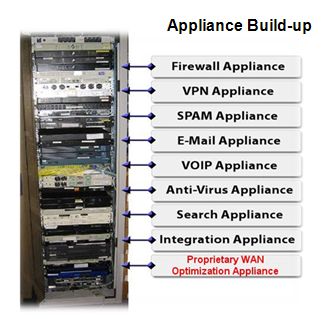Virtualization continues to be a hot topic and cloud computing is scorching, but when embracing a trend, it’s important to know exactly why you are doing it and how it will impact your bottom line. And software appliances are one of these new and growing trends.
Certeon is one of the first companies to offer application acceleration as a fully virtual appliance. And the company looked long and hard at the reasons why it made sense to shift their entire business model from hardware to software. So who better to help me with this issue and explain the trend toward software appliances?
When asked, Certeon said they narrowed it down to the top 8 reasons why hardware falls short of software when serving up WAN optimization and application acceleration to distributed enterprises. This list includes looking at issues such as TCO, energy, deployment, and the downside of what they call “appliance build-up.”
So what, then, are the top reasons that Certeon came up with?
1. Flexibility to Run on Industry Standard Servers and Hypervisors – A software virtual appliance can run on an industry standard server and hypervisor, which enables the following:
- servers to be consolidated without the need for adding additional hardware to power, cool, and manage, thereby eliminating “appliance build-up”
- server upgrades to be made by adding components (CPU, memory, storage) rather than forklift upgrades
- other applications to run on that server along with the virtual appliance software, without limitations
2. Learning to Share Means No More Underutilized Resources – Virtualized appliances can share system resources (CPU, memory, disk) with other VM applications, making inefficient use of appliance resources a thing of the past.

3. Dynamic Resource Allocation (DRS) – DRS provides the ability to manage system resources based on changes in load or requirements. DRS will do the same for an application acceleration virtual appliance, enabling it to be allocated to save on network bandwidth and dramatically increase application performance to remote users where needed. This also means a new level of scalability: virtual appliance software can leverage increases in system resources without “forklift” upgrades of hardware appliances.
4. Virtual Machine Movement – Virtual machine resources can be dynamically moved without disrupting processes and allocated where there is the most need. The same applies for a virtual appliance that enables WAN optimization and application acceleration services to be moved from one machine to another without disruption of services.
5. High Availability – Hardware or software failure used to be an IT catastrophe. A virtual appliance leverages the high-availability features of a virtual machine with no break in service.
6. Central Deployment and Management – Now virtual appliance images can be deployed and provisioned via virtual machine central management systems such as VMware Virtual Center or Microsoft System Center Virtual Machine Manager from a central datacenter to a virtual server anywhere within the enterprise.
7. Lower Cost – This one’s a no-brainer: software is cheaper to buy and maintain. Specifically for virtualized application acceleration, testing results have shown up to 60% lower TCO than using hardware WAN optimization appliances.
8. Ease of Deployment, Ease of Operations – Shipping hardware appliances to multiple remote offices is not required, and with a virtual appliance you can centrally manage software distribution, setup, and updates to get up (and stay up) right away.
What do you think? What are your thoughts about software and hardware appliances?